![]()
![]()
![]()
Use LEFT and RIGHT arrow keys to navigate between flashcards;
Use UP and DOWN arrow keys to flip the card;
H to show hint;
A reads text to speech;
103 Cards in this Set
- Front
- Back
- 3rd side (hint)
|
Convergent evolution |
A trait in two species that evolved independently of each other. |
|
|
|
Paraphyletic |
Contains some, not all, descendants of the common ancestor |
Reptilia without birds |
|
|
Polyphyly |
Taxonomic group doesn't contain most recent common ancestor of all members of the group. |
Mammals and birds, without their recent common ancestor included |
|
|
Polytomy |
Branching sequence of 3 or more lineages can't be determined. |
|
|
|
Derived character |
Differs in form from ancestral character |
Apomorphy |
|
|
Amniotic egg |
Tough shell and four structures called extraembryonic membranes. |
|
|
|
Plesiomorphy |
Ancestral character |
|
|
|
Apomorphy |
Derived character |
|
|
|
Synapomorphy |
Derived character by two or more taxa |
Shared derived character, share common ancestor |
|
|
Homoplasies |
Derived characters arising from convergent evolution |
|
|
|
Node-based definition |
Includes most recent common ancestor of at least two taxa |
Crown group |
|
|
Stem-based definition |
Diverge before the crown group |
|
|
|
Holotype |
Individual that possesses all characteristics of that species |
|
|
|
Major difference between water and land living |
Gravity and the effects on the skeletal system |
|
|
|
Adaptations associated with land on the skeletal system |
Pectoral and pelvic girdle (support forelimb and hindlimb), vertebrae, limbs |
|
|
|
Terrestrial gas exchange occurs how? |
Cutaneous (skin), buccopharynx, and lungs. |
|
|
|
Tetrapods arose from what fish? |
Sarcopterygii |
|
|
|
Homologous |
Derived from same fundamental structure |
Tetrapod humerus and femur derived from coelecanth limb girdle |
|
|
Water to land tetrapodomorph |
Tiktaalik |
Able to turn it's head, strong pelvic and pectoral girdle |
|
|
Temnospondly hypothesis |
Body of vertebrae two regions surrounding notochord (intercentrum and pleurocentra), most widely accepted |
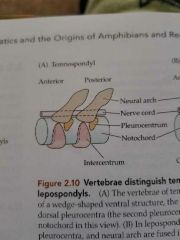
Evolved from Temnospondyli, then Lissamphibia |
|
|
Lepospondyl hypothesis |
One centrum fused to neural arch, microsaurs |
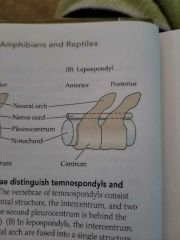
Evolved from Lissamphibia, Temnospondyli is a separate clade. |
|
|
Temnospondyl example |
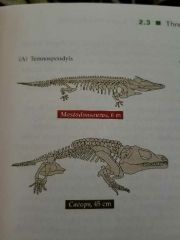
|
|
|
|
Lopospondyls example |
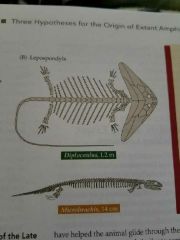
|
|
|
|
Diphyly hypothesis |
Hybrid between temno and lepo, frogs and salamanders from temp and caecilians from lepo. |
Less accepted |
|
|
What is the Romer's Gap? |
30mil year gap of no fossils |
|
|
|
Characteristics unique to Lissamphibian monophyly |
1) Teeth are pedicellate and bicuspid 2) Middle Ear: stapes and operculum, allows ground vibrations to be transmitted to forelimb then to inner ear 3) Skin contains mucus and poison (glandular) glands 4) Radius and ulna articulate with a single structure on the humerus called the radial condyle. |
|
|
|
Heterochromy |
Change in timing of embryonic and juvenile development affects sexually mature adults phenotype |
|
|
|
Paedomorphosis |
Retention of juvenile characteristics |
|
|
|
Contents of amniotic egg |
Hard shell, yolk sac (stores energy), fluid-filled amnion (surrounds and cushions embryo), chorion and allantois (gas exchange, store waste) |
|
|
|
Characteristics of monophyl Amniota |
Skull characters, pectoral girdle, and appendicular skeleton |
|
|
|
Fenestrae |
"Window" in skull allowing for bulging muscles |
|
|
|
Diapsid fenestrae |
2. In lizard, the second one is a half moon. All extant reptiles except for turtles. |
|
|
|
Synapsid fenestrae |
1. Mammals and humans. |
|
|
|
Anapsid fenestrae |
0. Turtles. |
|
|
|
Lepidosauria descendants |
Squamata: snakes and lizards Rhynchocephalia: tuatara |
Diapsida> Lepidosauria |
|
|
Archosauria descendants |
Crurotarsi: crocodiles Avemetatarsalia: pterosaurs, dinosaurs, birds |
Diapsida> Archosauria |
|
|
What time period is the amphibians common ancestor |
Early Carboniferous |
|
|
|
2 common characteristics of amphibians |
Complex life history, permeable skin |
|
|
|
Estivation |
Prolonged periods of dormancy |
|
|
|
Breeding glands |
Sexually dimorohic mucus glands |
|
|
|
Nuptial pads |
Breeding glands on hands and/or feet |
|
|
|
Granular glands |
Provide defensive secretions, toxic amines, peptides, alkaloids |
|
|
|
Chromatophores |
Specialized cells providing color and color changes |
|
|
|
Xanthophores |
Color cells: red, yellow and orange |
|
|
|
Iridophores |
Color cells: reflect white, silver, blue |
|
|
|
Melanophores |
Color cells: contains melanin, dark brown or black |
|
|
|
Caudata |
Salamanders |
|
|
|
Costal grooves |
Facilitate water movement over body |
|
|
|
Spermatophores |
Sperm packet places on substrate by male, internal |
Salamander reproduction |
|
|
Cryptobrachidae |
Hellbender and Giant Salamanders. Cold water, external fert, no tongue |
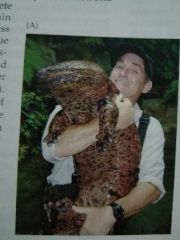
|
|
|
Hynobiidae |
Asian salamander. Complete metamorph, reduced or absent lung, external fert |

|
|
|
Sirenidae |
Sirens. Eel like, keratinized beak, non pedicellate teeth, external gills, internal fertilization |
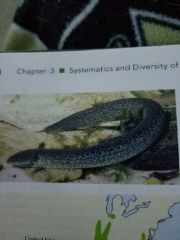
|
|
|
Salamandroidea characteristics |
98% of species, synapomorohy of internal fertilization |
|
|
|
Salamandridae |
Newts. Aquatic and/or terrestrial, suction feeding and tongue protrusion, some have dorsal crests, internal fert by spermatophore, oviparous, some highly toxic, life histories vary greatly between species |
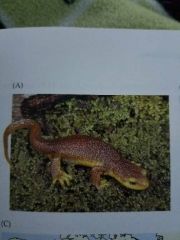
|
|
|
Ambyostomatidae |
Mole salamander. Faculative or obligate metamorphosis, axolotl is paedomorphic, adults terrestrial |
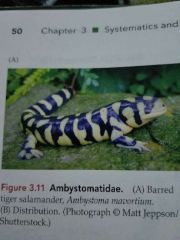
|
|
|
Dicamptodontidae |
Pacific Giant salamander. Dicamptodon copei permanently aquatic, external gills, metamorphosis faculative in all other species, direct development |
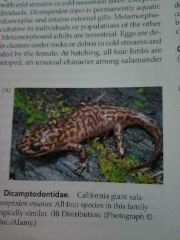
|
|
|
Proteidae |
Mudpuppies and Olms. Aquatic, paedomorphic, external gills, caudal fins, lack maxillary bones, oviparous. Olm: (Proteus) cold subterranean caves, white skin, reduced eyes |
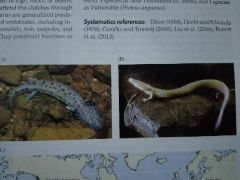
|
|
|
Rhyacotritonidae |
Torrent salamander. Squared off glands posterior to vent in males, no operculum, reduced lungs |
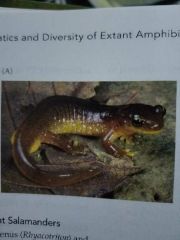
|
|
|
Amphiumidae |
Amphiumas. Elongate, paedomorphic, severely reduced limbs, large pedicellate teeth, internal fert |
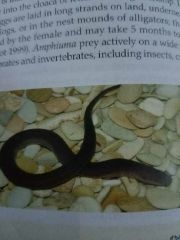
|
|
|
Plethodontidae |
Lungless salamanders. 2/3 of all species, cutaneous respiration, nasolabial groove in adults, all species greatly vary, ancestrally oviparous, females brood, direct development evolved 2 times |
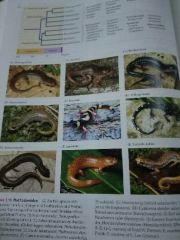
|
|
|
Anura |
All extant frog lineages |
|
|
|
Salienta |
All lineages more closely related to Anura than to other Lissamphibians, including extinct lineages that diverged before modern frogs |
|
|
|
Frog skeletal morphology |
Reduced skull, 9 presacral vertebrae, caudal vertebrae fused into a rod called the Urostyle, if they have a tail it is an extension of the cloaca, radius and ulna fused, tibia and fibula fused, |
|
|
|
What does a pectoral girdle do? |
Anchor forelimbs to the body and exhibit a wide range of variation in relation to locomotor range |
|
|
|
Inguinal amplexus |
Male ggrasps female around waist |
|
|
|
Axillary amplexus |
Female grasped immediately behind her forelimbs |
|
|
|
Cephalic amplexus |
Male positioned far forward on the forum of the female and clasps her head |
|
|
|
Denticles |
Used to scrape plant matter or detritus |
|
|
|
Spiracle in larvae |
Tadpoles take in water and pass over gills, exits through spiracle |
|
|
|
Tadpole types |
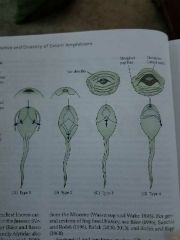
|
|
|
|
Ascaphidae |
Tailed frog. "Tail" (penis) an extension of the cloaca, 9 presacral vertebrae, absent eardrums, inguinal amplexus, tadpoles have suctorial discs |
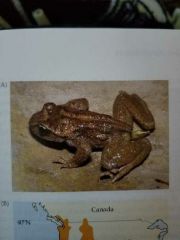
|
|
|
Leiopelmatidae |
NZ primitive frog. Inscriptial ribs embedded in ventral body musculature, lack tympana, long lived, tadpoles no jaw sheath or dentricles, 3/4 terrestrial species m carry babies on back |
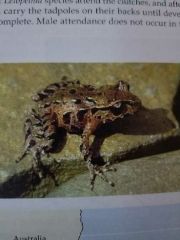
|
|
|
Bombinatoridae |
Fire bellied toad. Emit toxic secretions, lack lungs, aposematic coloration |

|
|
|
Alytidae |
Disc tongue frogs & midwife toads. Aquatic eggs and tadpoles, fossorial, inguinal amplexus, midwife toad m carries fertilized eggs on back, disc frog lays eggs into water |
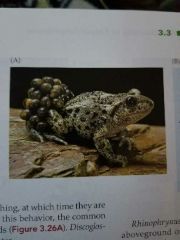
|
|
|
Rhinophrynidae |
Mexican burrowing toad. Spade on inner metatarsal tubercle and first toe, head pointed and thick, tympanum absent, lacks teeth, highly modified feeding apparatus to eat wants and termites |
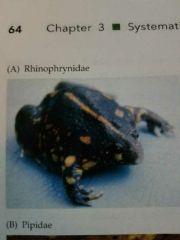
|
|
|
Pipidae |
African clawed frog & Suriname toads. Lack tongue, polyploid chromosomes, ampletic pairs swim in loops, eggs enveloped by f back skin, keratinous claws, |
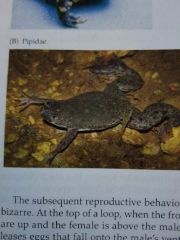
|
|
|
Scaphiopodidae |
North American spadefoot toad. Burrow, keratinous spadelike metatarsal tubercle, |
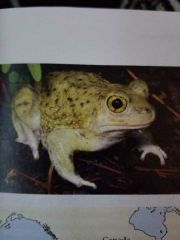
|
|
|
Pelodytidae |
Parsley frog. Nocturnal but diurnal during breeding, eggs attach to vegetation in ponds |
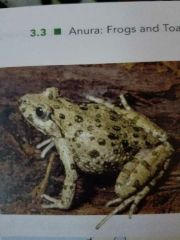
|
|
|
Pelobatidae |
Old world spadefoot toads. Spadelike metatarsal tubercle, glandular tuberculate skin, |
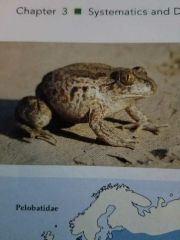
|
|
|
Megophryidae |
Asian toad. Rainforest, granular glands, eggs in streams, nuptial spines on upper lip of m & violently defend nests, tadpoles burrow in sand or gravel |
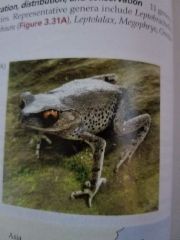
|
|
|
Heleophrynidae |
Ghost frog. Webbed feet, toe discs, |
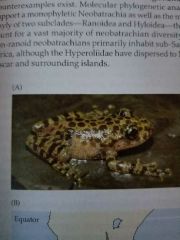
|
|
|
Sooglossidae |
Seychelles frog. Ancient lineage, moss forests, inguinal amplexus, direct development in S. gardeneri, others have eggs hatch on f back |

|
|
|
Nasikabatrachidae |
Purple pig nosed frog. Sister to Sooglossidae, bloated body, small head, prominent lip, burrower |
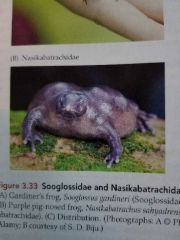
|
|
|
Myobatrachidae |
Digital discs small or absent, most terrestrial, tusk like teeth protrude from lower jaw, species have different larvae life cycle and nesting behaviors |
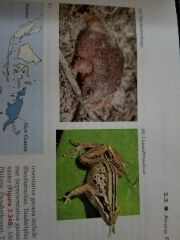
|
|
|
Calyptocephalellidae |
Chilean toad. Large with significant sexual dimorphism, Telmatobufo are smaller & tadpoles have large oral suckers |
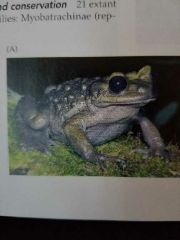
|
|
|
Elutherodactylidae |
New world rainfrogs. Direct development, some species internal fert, may be extinct |
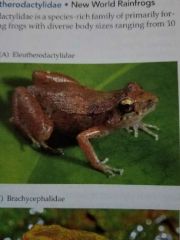
|
|
|
Ceuthomantidae |
Small, moisture restricted, probably direct development |
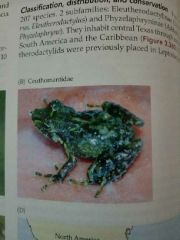
|
|
|
Brachycephalidae |
Reduced 2 digits on hands, inguinal amplexus shift to axillary, direct development, secrete neurotoxins, cryptically colored |
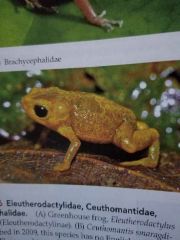
|
|
|
Craugastoridae |
Very diverse species in body and habitat, most stream dwelling, direct development, 3 species emit foul smelling fluids, |
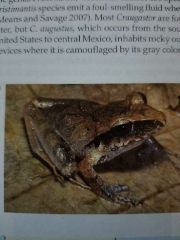
|
|
|
Centrolenidae |
Glass frogs. Transparent ventral skin, expanded toe discs, Tshaped terminal phalanges, egg clutches on veg above water, tadpoles drop into water, blood circulates close to skin |
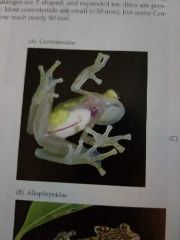
|
|
|
Allophryinidae |
Strongly ossified cranial roof, absent teeth, arboreal, form breeding aggregations in water, f deposits fertilized eggs into water |
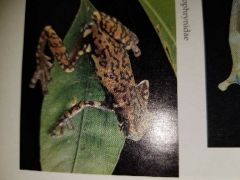
|
|
|
Telmatobiidae |
Large, high elevation in Andes, cold and deep lakes, foot webbing, reduced lungs |
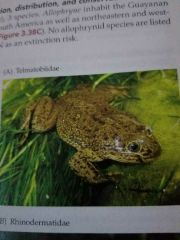
|
|
|
Rhinodermatidae |
Darwin's frogs. Fleshy proboscis at tip of snout, m attend to eggs on land, broods in vocal sacs |
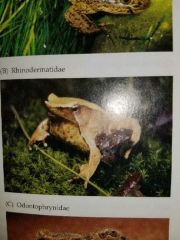
|
|
|
Odonrophrynidae |
Rotund body, numerous tubercles, horn like structure in some species, females choose partner |
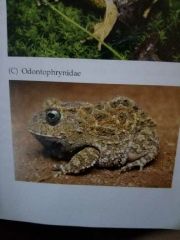
|
|
|
Leptodactylidae |
Species life history is very diverse, m call f to burrow, foam nest, f aggressively defends clutch, m defends entrance, underutilized eggs feed tadpoles. Split into two classes: sensu lato (11) and sensu stricto (14 genera) |

|
|
|
Hylodidae |
Small, diurnal frogs, m battles over territory, f deposit eggs in water |
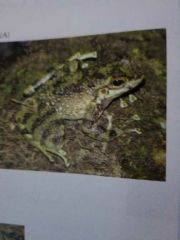
|
|
|
Hylidae |
American and AU treefrogs. Arboreal, toe discs and claw shaped terminal phalanges, some fossorial, dry enviro, co-ossification, aquatic ones have webbing, many produce a peptide from glands, axillary amplexus |
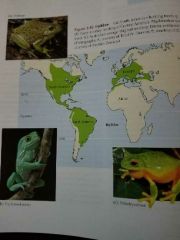
|
|
|
Hemiphractidae |
Horned & marsupial frogs. Terrestrial, robust, prominent sharp projections on head, tadpoles & young frogs carried on f back, marsupial frog |

|
|
|
Dendrobatidae |
Poison dart frogs. Small, toxic skin secretions alkaloid from diet, aposematic, cephalic amplexus, tadpoles adhere to parents back until deposited in water or arboreal sites, underutilized eggs feed to tadpoles, complex parental care |
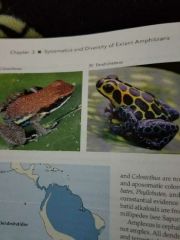
|
|
|
Cycloramphidae |
Large, dorsally compressed, webbed feet, species either lays tadpoles in streams (feed on banks), or terrestrial (feed on yolk) |

|
|
|
Ceratobatrachidae |
Direct development, terrestrial and arboreal, camo, fang like bony projections on mandible |
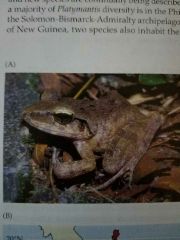
|
|
|
Bufonidae |
Most terrestrial, Bidders Organ (rudimentary ovary developed on larval m testes), absent teeth, heavily ossified skull, prominent cutaneous glands, some aposematic and toxic, reproduction varies |
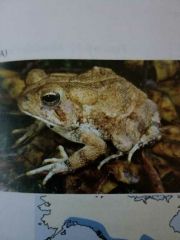
True toad & Harlequin frogs |
|
|
Alsodidae |
Slow moving streams, eat algae and plant material, prolong larval period (up to 2 years) |
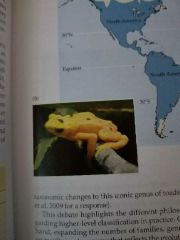
|

